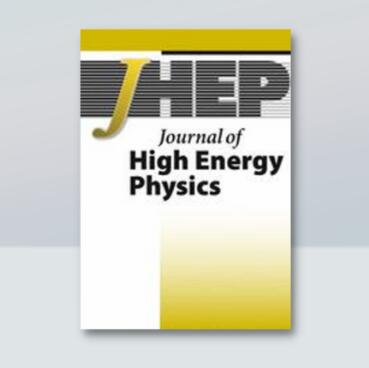d维多环积分的一元性
IF 5.5
1区 物理与天体物理
Q1 Physics and Astronomy
引用次数: 0
摘要
考虑多环积分的微分系统的单群。我们描述了一种简单的启发式方法来获得作为时空维数d的函数的单矩阵。我们观察到在一个特殊的基中,这些矩阵的元素是z = exp(iπd)的整数系数的Laurent多项式,即单群是GL(n, 0 [z, 1/z])的一子群。从扭曲黎曼双线性关系出发,导出了d维和d维单矩阵的双线性关系,并检验了所得到的单矩阵是否满足这些双线性关系。本文章由计算机程序翻译,如有差异,请以英文原文为准。
Monodromy of multiloop integrals in d dimensions
We consider the monodromy group of the differential systems for multiloop integrals. We describe a simple heuristic method to obtain the monodromy matrices as functions of space-time dimension d. We observe that in a special basis the elements of these matrices are Laurent polynomials in z = exp(iπd) with integer coefficients, i.e., the monodromy group is a subgroup of GL(n, ℤ[z, 1/z]). We derive bilinear relations for monodromies in d and –d dimensions which follow from the twisted Riemann bilinear relations and check that the found monodromy matrices satisfy them.
求助全文
通过发布文献求助,成功后即可免费获取论文全文。
去求助
来源期刊

Journal of High Energy Physics
物理-物理:粒子与场物理
CiteScore
10.30
自引率
46.30%
发文量
2107
审稿时长
1.5 months
期刊介绍:
The aim of the Journal of High Energy Physics (JHEP) is to ensure fast and efficient online publication tools to the scientific community, while keeping that community in charge of every aspect of the peer-review and publication process in order to ensure the highest quality standards in the journal.
Consequently, the Advisory and Editorial Boards, composed of distinguished, active scientists in the field, jointly establish with the Scientific Director the journal''s scientific policy and ensure the scientific quality of accepted articles.
JHEP presently encompasses the following areas of theoretical and experimental physics:
Collider Physics
Underground and Large Array Physics
Quantum Field Theory
Gauge Field Theories
Symmetries
String and Brane Theory
General Relativity and Gravitation
Supersymmetry
Mathematical Methods of Physics
Mostly Solvable Models
Astroparticles
Statistical Field Theories
Mostly Weak Interactions
Mostly Strong Interactions
Quantum Field Theory (phenomenology)
Strings and Branes
Phenomenological Aspects of Supersymmetry
Mostly Strong Interactions (phenomenology).
 求助内容:
求助内容: 应助结果提醒方式:
应助结果提醒方式:


